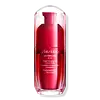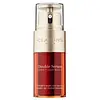What's inside
What's inside
 Key Ingredients
Key Ingredients

 Benefits
Benefits

 Concerns
Concerns

 Ingredients Side-by-side
Ingredients Side-by-side

Water
Skin ConditioningDimethicone
EmollientGlycerin
HumectantDipropylene Glycol
HumectantSd Alcohol 40-B
AstringentSorbitol
HumectantPEG-10 Dimethicone
Skin ConditioningDimethicone/Vinyl Dimethicone Crosspolymer
Skin ConditioningCalcium Stearate
Cosmetic ColorantXylitol
HumectantMethyl Gluceth-10
EmulsifyingSodium Chloride
MaskingPEG/PPG-19/19 Dimethicone
EmulsifyingHydrogenated Polyisobutene
EmollientPhenoxyethanol
PreservativeCetyl Ethylhexanoate
EmollientErythritol
HumectantButylene Glycol
HumectantCellulose Gum
Emulsion StabilisingPEG/PPG-14/7 Dimethyl Ether
Skin ConditioningTocopheryl Acetate
AntioxidantRosa Damascena Flower Water
MaskingAlcohol
AntimicrobialParfum
MaskingTocopherol
AntioxidantDisodium EDTA
Ectoin
Skin ConditioningPhytosteryl/Octyldodecyl Lauroyl Glutamate
Skin ConditioningPPG-3 Dipivalate
Skin ConditioningLinalool
PerfumingSodium Metabisulfite
AntioxidantGeraniol
PerfumingSodium Carboxymethyl Beta-Glucan
CleansingGinkgo Biloba Leaf Extract
Skin ConditioningCitronellol
PerfumingZiziphus Jujuba Fruit Extract
Skin ConditioningOriganum Majorana Leaf Extract
AntiseborrhoeicNelumbo Nucifera Germ Extract
Skin ConditioningHydroxyproline
Skin ConditioningHouttuynia Cordata Extract
Skin ConditioningLactobacillus/Hibiscus Sabdariffa Flower Ferment Filtrate
Skin ConditioningSanguisorba Officinalis Root Extract
CleansingThymus Serpyllum Extract
Skin ConditioningPerilla Ocymoides Leaf Extract
TonicIris Florentina Root Extract
MaskingGanoderma Lucidum Stem Extract
Skin ConditioningWater, Dimethicone, Glycerin, Dipropylene Glycol, Sd Alcohol 40-B, Sorbitol, PEG-10 Dimethicone, Dimethicone/Vinyl Dimethicone Crosspolymer, Calcium Stearate, Xylitol, Methyl Gluceth-10, Sodium Chloride, PEG/PPG-19/19 Dimethicone, Hydrogenated Polyisobutene, Phenoxyethanol, Cetyl Ethylhexanoate, Erythritol, Butylene Glycol, Cellulose Gum, PEG/PPG-14/7 Dimethyl Ether, Tocopheryl Acetate, Rosa Damascena Flower Water, Alcohol, Parfum, Tocopherol, Disodium EDTA, Ectoin, Phytosteryl/Octyldodecyl Lauroyl Glutamate, PPG-3 Dipivalate, Linalool, Sodium Metabisulfite, Geraniol, Sodium Carboxymethyl Beta-Glucan, Ginkgo Biloba Leaf Extract, Citronellol, Ziziphus Jujuba Fruit Extract, Origanum Majorana Leaf Extract, Nelumbo Nucifera Germ Extract, Hydroxyproline, Houttuynia Cordata Extract, Lactobacillus/Hibiscus Sabdariffa Flower Ferment Filtrate, Sanguisorba Officinalis Root Extract, Thymus Serpyllum Extract, Perilla Ocymoides Leaf Extract, Iris Florentina Root Extract, Ganoderma Lucidum Stem Extract
Water
Skin ConditioningCetearyl Isononanoate
EmollientGlycerin
HumectantIsononyl Isononanoate
EmollientCaprylic/Capric Triglyceride
MaskingPentylene Glycol
Skin ConditioningPPG-3 Myristyl Ether
EmollientEthylene/Propylene/Styrene Copolymer
Dipsacus Sylvestris Extract
Skin ConditioningButylene Glycol
HumectantParfum
MaskingPhenoxyethanol
PreservativePropanediol
SolventTromethamine
BufferingSilybum Marianum Seed Oil
Skin ConditioningCarbomer
Emulsion StabilisingTocopheryl Acetate
AntioxidantEscin
TonicChenopodium Quinoa Seed Extract
Skin ConditioningEthylhexylglycerin
Skin ConditioningSqualane
EmollientAvena Sativa Kernel Extract
AbrasiveTheobroma Cacao Extract
Skin ConditioningButylene/Ethylene/Styrene Copolymer
Leontopodium Alpinum Extract
Skin ConditioningXanthan Gum
EmulsifyingPersea Gratissima Oil Unsaponifiables
Skin ConditioningCaramel
Cosmetic ColorantCurcuma Longa Root Extract
MaskingSalicyloyl Phytosphingosine
Skin ConditioningMusa Sapientum Fruit Extract
Skin ConditioningSalicornia Herbacea Extract
Skin ConditioningActinidia Chinensis Fruit Extract
EmollientKalanchoe Pinnata Leaf Extract
MaskingSodium Benzoate
MaskingCitric Acid
BufferingMyrothamnus Flabellifolia Leaf/Stem Extract
HumectantDisodium EDTA
Tocopherol
AntioxidantLycium Barbarum Fruit Extract
AstringentMaltodextrin
AbsorbentOrthosiphon Stamineus Extract
Skin ConditioningHedychium Coronarium Root Extract
MaskingMangifera Indica Leaf Extract
Skin ConditioningPotassium Sorbate
PreservativePentaerythrityl Tetra-Di-T-Butyl Hydroxyhydrocinnamate
AntioxidantJania Rubens Extract
Skin ConditioningAscorbic Acid
AntioxidantSodium Citrate
BufferingEngelhardtia Chrysolepis Leaf Extract
Skin ConditioningCI 14700
Cosmetic ColorantCallicarpa Japonica Fruit Extract
Skin ConditioningWater, Cetearyl Isononanoate, Glycerin, Isononyl Isononanoate, Caprylic/Capric Triglyceride, Pentylene Glycol, PPG-3 Myristyl Ether, Ethylene/Propylene/Styrene Copolymer, Dipsacus Sylvestris Extract, Butylene Glycol, Parfum, Phenoxyethanol, Propanediol, Tromethamine, Silybum Marianum Seed Oil, Carbomer, Tocopheryl Acetate, Escin, Chenopodium Quinoa Seed Extract, Ethylhexylglycerin, Squalane, Avena Sativa Kernel Extract, Theobroma Cacao Extract, Butylene/Ethylene/Styrene Copolymer, Leontopodium Alpinum Extract, Xanthan Gum, Persea Gratissima Oil Unsaponifiables, Caramel, Curcuma Longa Root Extract, Salicyloyl Phytosphingosine, Musa Sapientum Fruit Extract, Salicornia Herbacea Extract, Actinidia Chinensis Fruit Extract, Kalanchoe Pinnata Leaf Extract, Sodium Benzoate, Citric Acid, Myrothamnus Flabellifolia Leaf/Stem Extract, Disodium EDTA, Tocopherol, Lycium Barbarum Fruit Extract, Maltodextrin, Orthosiphon Stamineus Extract, Hedychium Coronarium Root Extract, Mangifera Indica Leaf Extract, Potassium Sorbate, Pentaerythrityl Tetra-Di-T-Butyl Hydroxyhydrocinnamate, Jania Rubens Extract, Ascorbic Acid, Sodium Citrate, Engelhardtia Chrysolepis Leaf Extract, CI 14700, Callicarpa Japonica Fruit Extract
 Reviews
Reviews

Ingredients Explained
These ingredients are found in both products.
Ingredients higher up in an ingredient list are typically present in a larger amount.
Butylene Glycol (or BG) is used within cosmetic products for a few different reasons:
Overall, Butylene Glycol is a safe and well-rounded ingredient that works well with other ingredients.
Though this ingredient works well with most skin types, some people with sensitive skin may experience a reaction such as allergic rashes, closed comedones, or itchiness.
Learn more about Butylene GlycolDisodium EDTA plays a role in making products more stable by aiding other preservatives.
It is a chelating agent, meaning it neutralizes metal ions that may be found in a product.
Disodium EDTA is a salt of edetic acid and is found to be safe in cosmetic ingredients.
Learn more about Disodium EDTAGlycerin is already naturally found in your skin. It helps moisturize and protect your skin.
A study from 2016 found glycerin to be more effective as a humectant than AHAs and hyaluronic acid.
As a humectant, it helps the skin stay hydrated by pulling moisture to your skin. The low molecular weight of glycerin allows it to pull moisture into the deeper layers of your skin.
Hydrated skin improves your skin barrier; Your skin barrier helps protect against irritants and bacteria.
Glycerin has also been found to have antimicrobial and antiviral properties. Due to these properties, glycerin is often used in wound and burn treatments.
In cosmetics, glycerin is usually derived from plants such as soybean or palm. However, it can also be sourced from animals, such as tallow or animal fat.
This ingredient is organic, colorless, odorless, and non-toxic.
Glycerin is the name for this ingredient in American English. British English uses Glycerol/Glycerine.
Learn more about GlycerinParfum is a catch-all term for an ingredient or more that is used to give a scent to products.
Also called "fragrance", this ingredient can be a blend of hundreds of chemicals or plant oils. This means every product with "fragrance" or "parfum" in the ingredients list is a different mixture.
For instance, Habanolide is a proprietary trade name for a specific aroma chemical. When used as a fragrance ingredient in cosmetics, most aroma chemicals fall under the broad labeling category of “FRAGRANCE” or “PARFUM” according to EU and US regulations.
The term 'parfum' or 'fragrance' is not regulated in many countries. In many cases, it is up to the brand to define this term.
For instance, many brands choose to label themselves as "fragrance-free" because they are not using synthetic fragrances. However, their products may still contain ingredients such as essential oils that are considered a fragrance by INCI standards.
One example is Calendula flower extract. Calendula is an essential oil that still imparts a scent or 'fragrance'.
Depending on the blend, the ingredients in the mixture can cause allergies and sensitivities on the skin. Some ingredients that are known EU allergens include linalool and citronellol.
Parfum can also be used to mask or cover an unpleasant scent.
The bottom line is: not all fragrances/parfum/ingredients are created equally. If you are worried about fragrances, we recommend taking a closer look at an ingredient. And of course, we always recommend speaking with a professional.
Learn more about ParfumPhenoxyethanol is a preservative that has germicide, antimicrobial, and aromatic properties. Studies show that phenoxyethanol can prevent microbial growth. By itself, it has a scent that is similar to that of a rose.
It's often used in formulations along with Caprylyl Glycol to preserve the shelf life of products.
Tocopherol (also known as Vitamin E) is a common antioxidant used to help protect the skin from free-radicals and strengthen the skin barrier. It's also fat soluble - this means our skin is great at absorbing it.
Vitamin E also helps keep your natural skin lipids healthy. Your lipid skin barrier naturally consists of lipids, ceramides, and fatty acids. Vitamin E offers extra protection for your skin’s lipid barrier, keeping your skin healthy and nourished.
Another benefit is a bit of UV protection. Vitamin E helps reduce the damage caused by UVB rays. (It should not replace your sunscreen). Combining it with Vitamin C can decrease sunburned cells and hyperpigmentation after UV exposure.
You might have noticed Vitamin E + C often paired together. This is because it is great at stabilizing Vitamin C. Using the two together helps increase the effectiveness of both ingredients.
There are often claims that Vitamin E can reduce/prevent scarring, but these claims haven't been confirmed by scientific research.
Learn more about TocopherolTocopheryl Acetate is AKA Vitamin E. It is an antioxidant and protects your skin from free radicals. Free radicals damage the skin by breaking down collagen.
One study found using Tocopheryl Acetate with Vitamin C decreased the number of sunburned cells.
Tocopheryl Acetate is commonly found in both skincare and dietary supplements.
Learn more about Tocopheryl AcetateWater. It's the most common cosmetic ingredient of all. You'll usually see it at the top of ingredient lists, meaning that it makes up the largest part of the product.
So why is it so popular? Water most often acts as a solvent - this means that it helps dissolve other ingredients into the formulation.
You'll also recognize water as that liquid we all need to stay alive. If you see this, drink a glass of water. Stay hydrated!
Learn more about Water